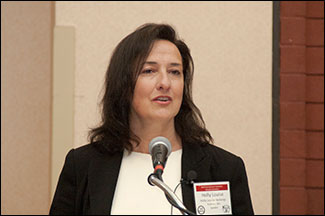Genetic Edge to BRDC Resistance
Moderate heritability for resistance to the bovine respiratory disease complex offers economic incentive for calculating GE-EPDs for the trait.
by Troy Smith, field editor, Angus Journal®
LINCOLN, Neb. (June 20, 2014) — The development of genomic breeding values for sires that produce calves that are less susceptible to bovine respiratory disease is under way. According to Washington State University animal geneticist Holly Neibergs, the effort to calculate genomic-enhanced expected progeny difference (GE-EPD) values for disease susceptibility is part of ongoing, multi-institutional research driven by USDA-grant funding. Neibergs explained why the research matters in a presentation to the 2014 Beef Improvement Federation (BIF) symposium June 18-21 in Lincoln, Neb.

Washington State University animal geneticist Holly Neibergs noted costs attributable to BRDC include prevention and treatment products, labor, and death loss, but the biggest hit comes from reduced carcass value.
According to Neibergs, the bovine respiratory disease complex (BRDC) is the most prevalent and costly disease challenge for the U.S. beef industry. Despite efforts to suppress the disease through vaccination and metaphylaxis (mass treatment with antimicrobials) incidence of the disease remains relatively unchanged. BRDC morbidity and mortality rates have stood at about the same levels for 20 years. Neibergs called BRDC a significant health management challenge for 97% of U.S. cattle-feeding operations.
“That’s probably underestimated, since more than 60% of all slaughter cattle show some evidence of lung lesions resulting from BRDC, even though some cases of illness in the feedlot went undetected,” added Neibergs.
Costs attributable to BRDC include prevention and treatment products, labor, and death loss, but the biggest hit comes from reduced carcass value. Generally, cattle experiencing BRDC produce fewer carcasses of Choice quality grade than do healthy cattle. Neibergs said recent research findings support that which virtually all cattle feeders have experienced.
“It wasn’t slippage from Choice to Select. Instead, [BRDC-affected cattle] actually fell off the grid. They went to no-roll, were condemned at slaughter or died before they got there,” reported Neibergs.
Research suggests the average loss in value for BRDC cases, compared to healthy animals, was $162.78 in 2013. That’s money lost as a result of reduced carcass quality. Add in treatment costs, and the estimated cost of each BRDC case in the feedlot is more than $200.
The good news comes through evidence indicating susceptibility to BRDC is at least partially a result of genetic predisposition. Differences in BRDC susceptibility have been found between cattle breeds and between sire lines. Heritability is estimated to be in the low to moderate range. This suggests that selecting for BRDC-resistant cattle could have a real effect on disease prevalence and industry profitability.
“If we want to get serious about this,” Neibergs stated, “I think there is some opportunity.”
The 2014 BIF Annual Meeting & Research Symposium was hosted by the University of Nebraska–Lincoln, the U.S. Meat Animal Research Center and the Nebraska Cattlemen June 18-21 in Lincoln, Neb. The Angus Journal and LiveAuctions.tv provide comprehensive online coverage of the event at www.BIFconference.com. Visit the Newsroom for summaries, proceedings, PowerPoints and audio of the sessions; the Awards page for announcements of award winners; and the Photos page for galleries of photos from the meeting and the tours.
Editor’s Note: This summary was written under contract or by staff of the Angus Journal®.Through an agreement with the Beef Improvement Federation, we are encouraging reprinting of the articles to those who will adhere to the reprint guidelines available on this site. Please review those guidelines or contact Shauna Rose Hermel, editor, at 816-383-5270. PowerPoints are posted with permission of the presenter and may not be reproduced in whole or in part without the express permission of the presenter.
The Angus Journal's coverage of the event is made possible through collaboration with BIF and sponsorship of LiveAuctions.tv. For questions about this site, or to notify us of broken links, click here.
Headquartered in Saint Joseph, Mo., Angus Productions Inc. (API) publishes the Angus Journal, the Angus Beef Bulletin, the Angus Beef Bulletin EXTRA, and the Angus Journal Daily, as well as providing online coverage of events and topics pertinent to cattlemen through the Angus Journal Virtual Library.



